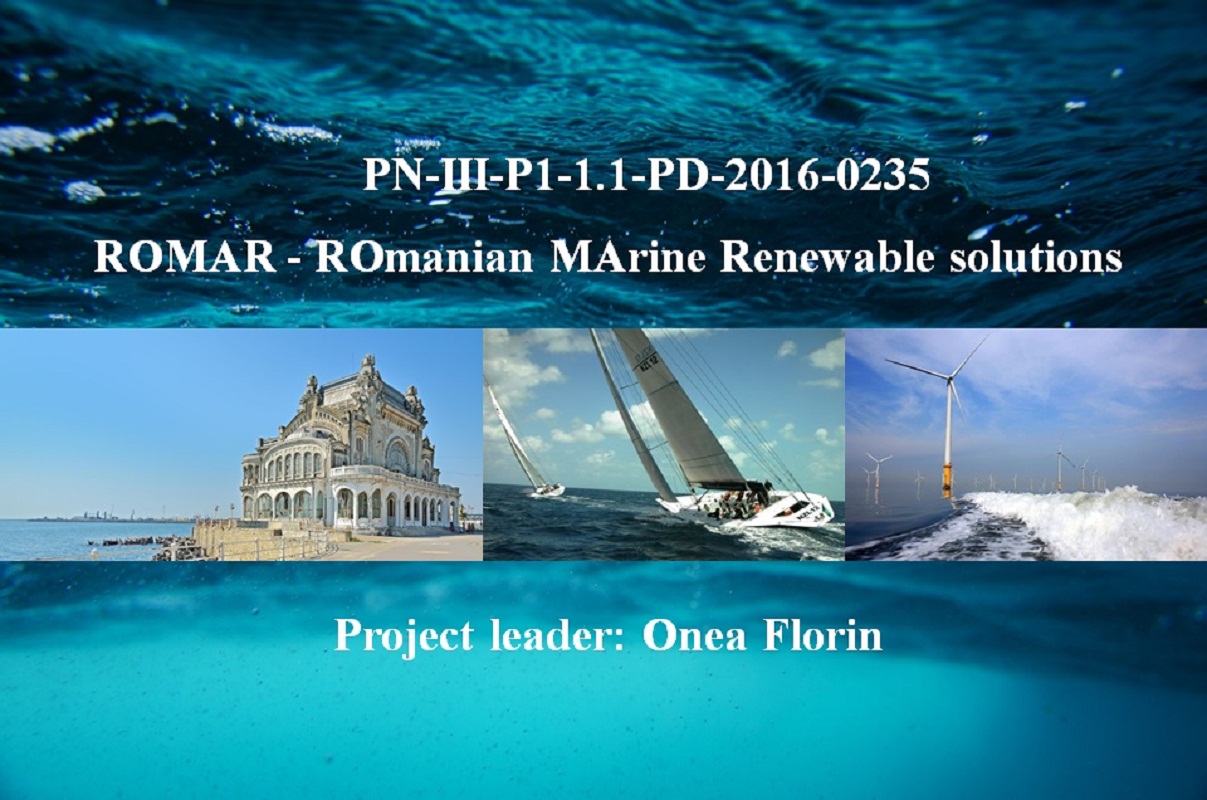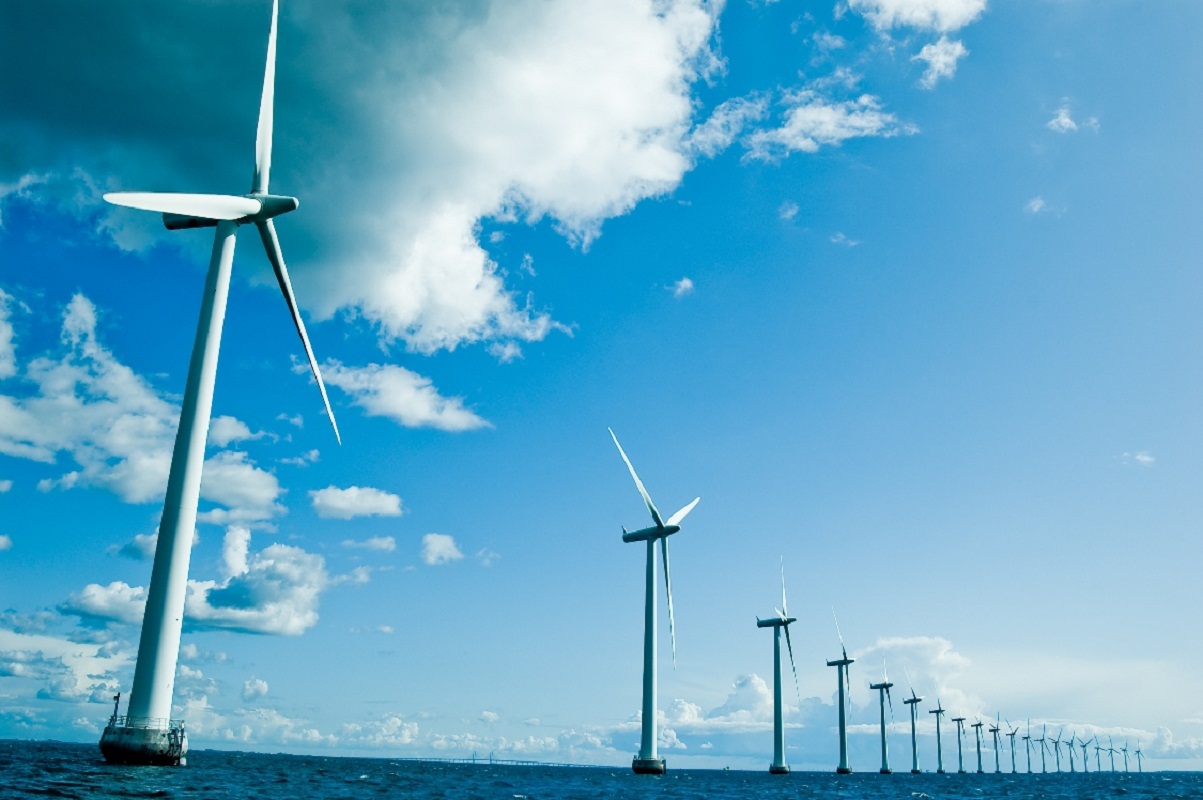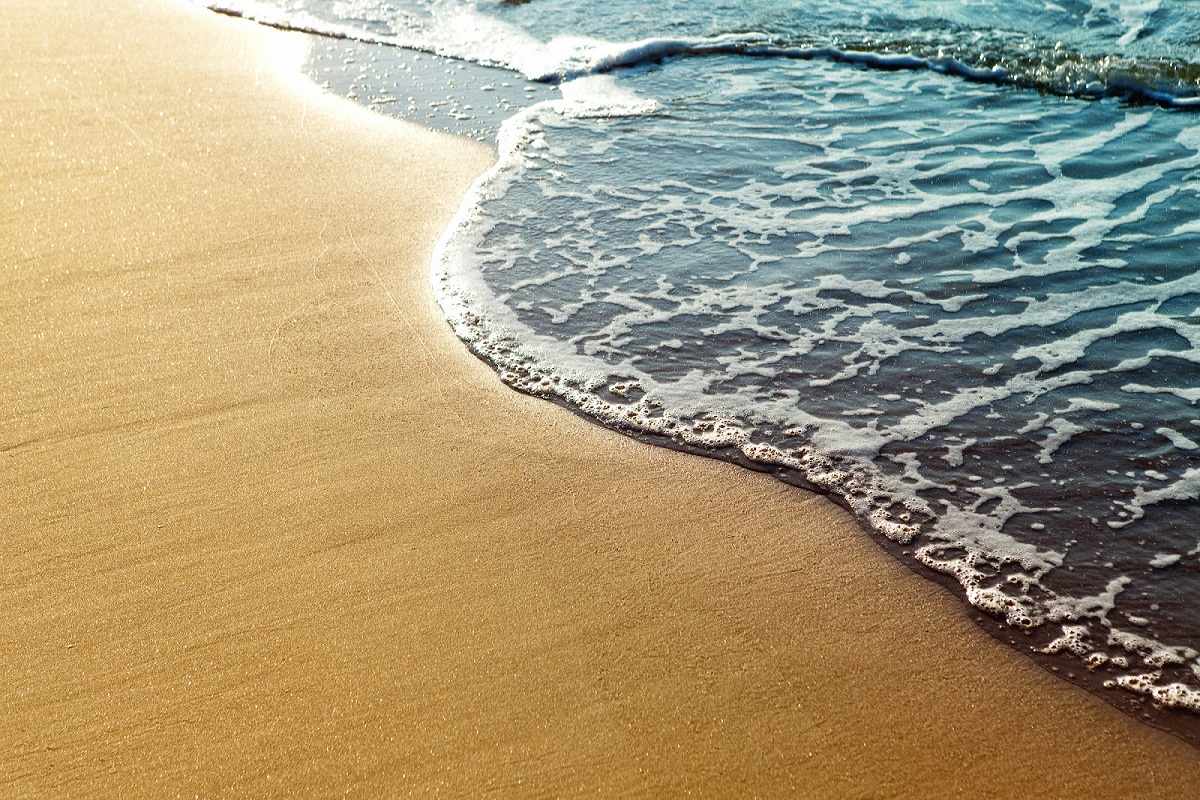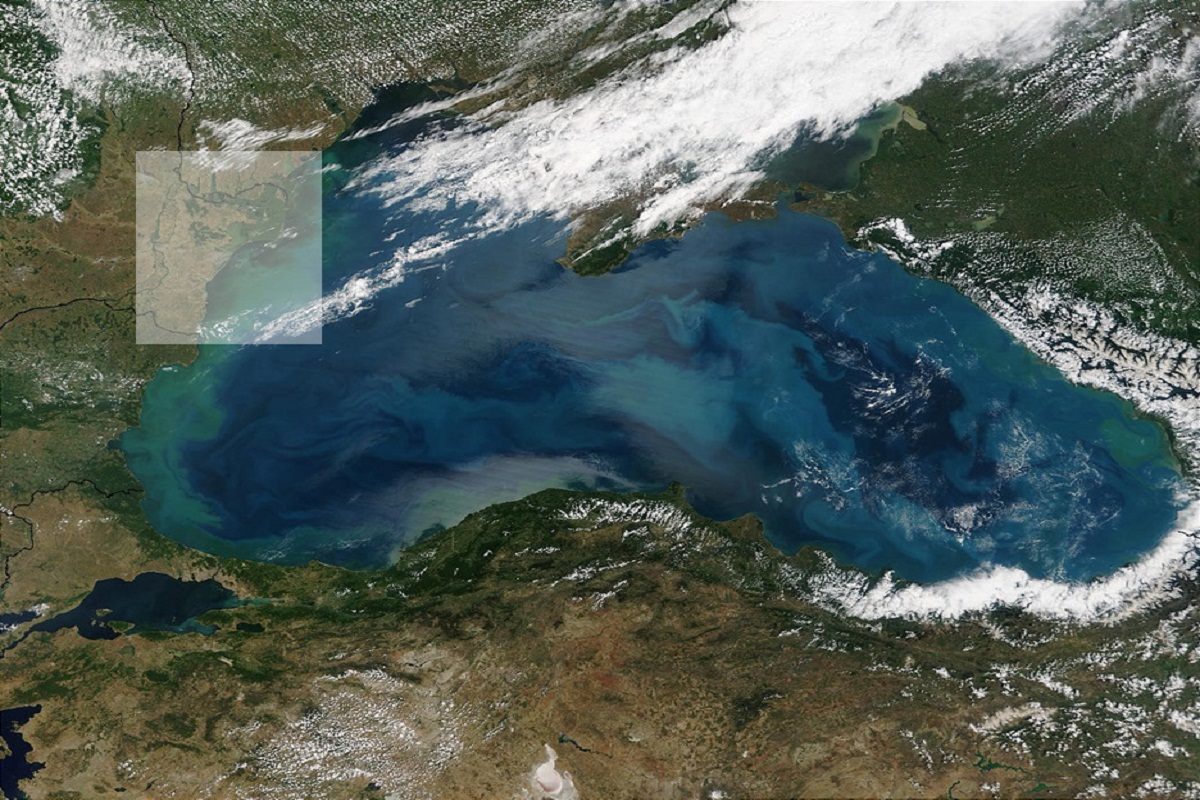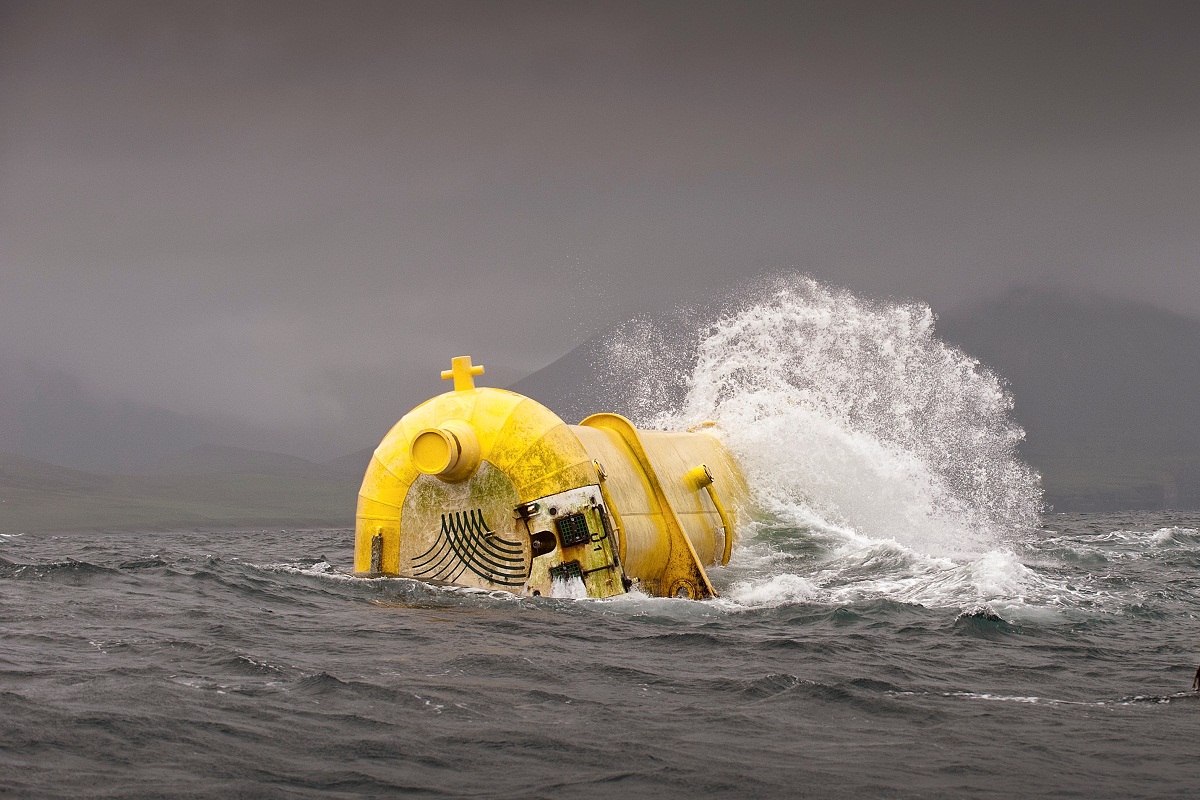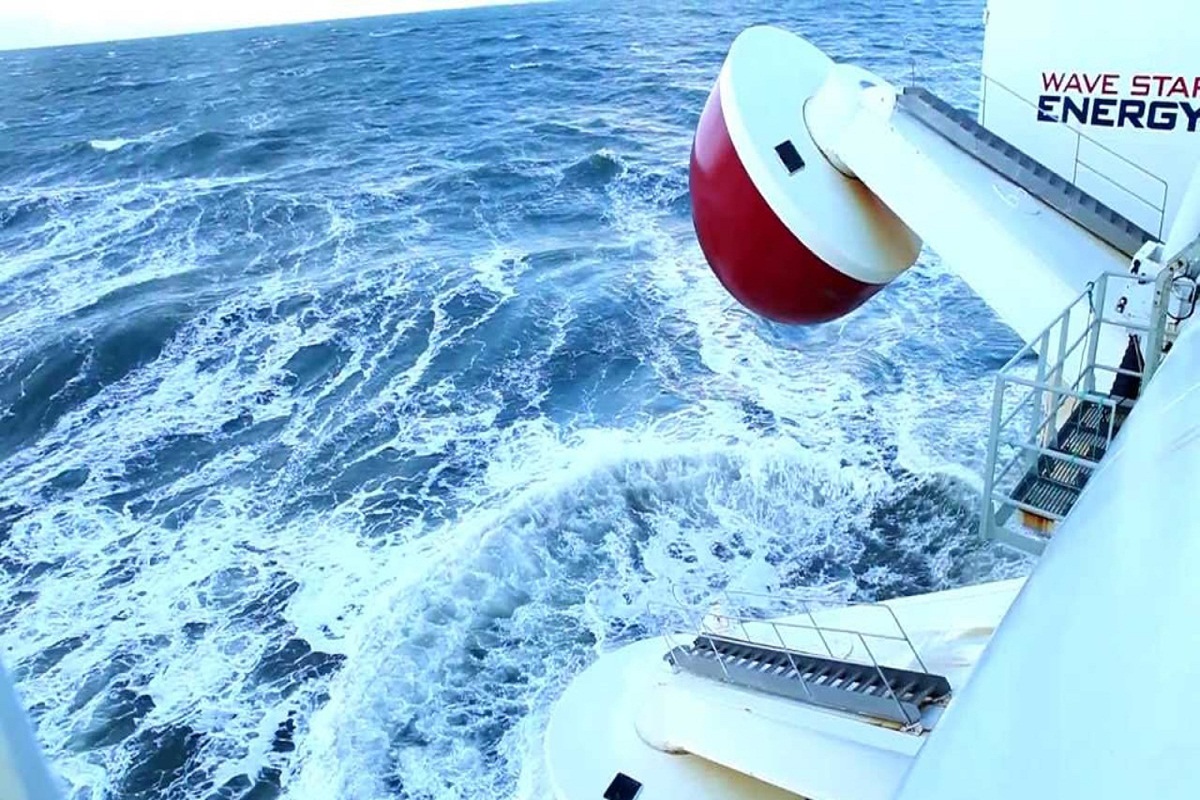
romar
Renewable Energy extraction in MARine environment and its Coastal impact
pn-iii-p4-id-pce-2016-0017

postdoctoral research project
Contract no. 72/2018. Source of funding: The Executive Unit for Financing in Higher Education, Research, Development and Innovation (UEFISCDI).
Funding amount: 249.090 lei. Implementation period: May 2017 - April 2020 (24 months).
Project Description
The present project (ROMAR - ROmanian MArine Renewable solutions) is focused on the renewable energy sources located in the Romanian nearshore area, in order to establish the viability of a wind, wave or hybrid wind-wave project, respectively. For accomplishing these targets, the project will be focused on three main directions. The first one is related to the assessment of an offshore wind farm performance by considering different spatial configurations and some state-of-the-art wind generators, which currently operate on the European sites.
Following these results, will be possible to establish the most suitable wind farm configuration for the Romanian nearshore by taking into account various parameters, such as: cost investment or efficiency. Another important direction is related to the assessment of the wave energy and of the performances of various Wave Energy Converters (WECs) which could operate in the vicinity of the Romanian nearshore. In this case, the viability of various onshore solutions to be integrated into the existing harbor infrastructure or costal protection systems will be discussed together with the possibility to couple a wave farm to an offshore wind project. Since the Romanian coastal area is severely affected by the erosion processes, in the final part of the project the aim is to identify an optimal solution in order to reduce the impact of the wave energy in some key nearshore sectors, such as the Danube Delta.
These studies can be considered to be opportune, since from the previous works it was established that the western part of the Black Sea presents more important wind and wave resources. This region is also defined by a shelf area, suitable for a marine farm if we consider the current trends reported by the European offshore wind industry. Moreover, during the recent years various renewable projects are started to emerge in enclosed basins such as the Mediterranean Sea, being also reported plans to develop offshore wind farms in the vicinity of the Bulgarian coasts.
Project Objectives
The present project is focused on the following specific objectives:
(O1) Performance assessment of a commercial offshore wind farm operating on various sites from the Romanian coastal environment;
(O2) Identify a portfolio of WECs which could efficiently operate in the marine conditions reported along the Black Sea coasts;
(O3) Estimation of the coastal impact induced by a wave farm or a hybrid wind-wave project which could operate in the vicinity of the Romanian area.
Activities according to project objectives
- A better understanding of the marine renewable potential reported in the Black Sea basin;
- A methodology development in order to assess the performances of a wind, wave or hybrid wind-wave project for various coastal environments;
- Development of a coupled modeling system, based on the SWAN model capable to evaluate the impact of a marine project onto the local wave, currents and sediment pattern;
- Assessment of a renewable project in the Black Sea, taking into account the investments costs and the expected outcomes;
- Identify the viability of an onshore WEC system to be incorporated in the infrastructure of an existing harbor;
- Accelerate the implementation of an wave farm into the enclosed sea basin and increase the performances of a such project by using the infrastructure of a wind farm;
- Assessment of the WEC systems impact on the local ecosystem.
From a scientific point of view, the main benefits coming from the present project will be:
- Development of a small amplitude wave converters designed for the Black Sea area;
- Implementation of a wind-wave project (or individual) in the Eastern Europe;
- Emergence of a new energy sector which means job opportunity;
- Reducing the expenses and effort required to conserve the coastal areas throughout classical solution (ex: artificial sanding or concrete breakwater).
Regarding the applicative directions which may results from the present project can be mentioned:
These measurements can be considered to be ineffective since they act only on the effects of the erosions, which are expected to increase due to climatic changes..
DISSEMINATION
2020
- Raileanu A, Onea F, Rusu E, 2020. An Overview of the Expected Shoreline Impact of the Marine Energy Farms Operating in Different Coastal Environments. J. Mar. Sci. Eng. 2020, 8, 228, (IF=1.732). https://www.mdpi.com/2077-1312/8/3/228 Papers presented in international scientific conferences
- Onea F, Rusu L, 2020. Impact Assessment of a Generic Wave Farm on the Wave Conditions at the Entrance to Danube Delta. Academics World International Conference, March 23–24, 2020, Bucureşti, România. http://www.academicsworld.org/Conference2020/Romania/1/ICRAMHS/ Papers presented in Romanian national conferences
- Ruiz A, Rusu E, Onea F, 2020. An Evaluation of the Offshore Wind Power Resources in the Spanish Nearshore. Scientific Conference organized by the Doctoral Schools of “Dunărea de Jos” University of Galati (SCDS-UDJG) 2020, June 18-19, 2020, Galati, Romania. (Accepted for presentation) http://www.cssd-udjg.ugal.ro/
-
Publications in journals with WoS quotations
2019
- Onea F, Rusu L, 2019. Long-term analysis of the Black Sea weather windows. J. Mar. Sci. Eng. 2019, 7, 303, (WoS:000487981700023, IF=1.732). https://www.mdpi.com/2077-1312/7/9/303
- Onea F, Rusu L, 2019. A study on the wind energy potential in the Romanian coastal environment. J. Mar. Sci. Eng. 2019, 7, 142, (WOS:000470965000022, IF=1.732). https://www.mdpi.com/2077-1312/7/5/142 Participation in international conferences and publication in conferences' proceedings
- Onea F, Rusu L, 2019. An overview of the Black Sea weather downtime. IISES International Academic Conference, Septembrie 23-26, 2019 Barcelona, Spania. https://www.iises.net/proceedings/international-academic-conference-barcelona/table-of-content/detail?article=an-overview-of-the-black-sea-weather-downtime
- Onea F, Rusu L, 2019. Assessment of the Romanian onshore and offshore wind energy potential. 2nd International Conference on Renewable Energy and Environment Engineering (REEE 2019), August 19-22, 2019 Munchen, Germania. https://doi.org/10.1051/e3sconf/201912201003
- Hobjila A, Onea F, Rusu L, 2019. Assessment of the weather windows availability related to the Black Sea maritime operations. CSSD-UDJG 2019, 13-14 Iunie 2019, Galati, Romania. http://www.cssd-udjg.ugal.ro/index.php/abstracts-2019
- Onea F, Rusu L, 2019. Offshore wind energy and the Romanian energy future. 4th International Conference on Advances on Clean Energy Research (ICACER 2019), Aprilie 5-7, 2019 Coimbra, Portugalia. https://doi.org/10.1051/e3sconf/201910301004
- Onea F, Rusu L, 2019. Wave power variation near the Romanian coastal waters. 4th International Conference on Advances on Clean Energy Research (ICACER 2019), Aprilie 5-7, 2019 Coimbra, Portugalia. https://doi.org/10.1051/e3sconf/201910301006 Training schools and annual assembly
- 1st WECANet Training Course on Wave Energy from 18-22 March 2019 in Varna, Bulgaria, https://www.researchgate.net/profile/Florin_Onea/project/ROmanian-MArine-Renewable-solutions-ROMAR/attachment/5cb8083e3843b01b9b9ad514/AS:748906392608769@1555564606778/download/Onea_Course+certificate.pdf?context=ProjectUpdatesLog.
- 1st WECANet Annual Assembly from 11-12 February 2019 in Thessaloniki, Greece, https://www.wecanet.eu/meeting-thessaloniki.
-
Publications in international journals
YEAR 2018
- Onea F, Rusu L, 2018. Evaluation of some state-of-the-art wind technologies in the nearshore of the Black Sea. Energies 11(9), 2452 (WoS, IF=2.676). https://www.mdpi.com/1996-1073/11/9/2452 Participation in international conferences and publication in conferences' proceedings
- Onea F, Rusu L, 2018. Evaluation of the Black Sea wind energy potential for a renewable energy perspective. 3rd International Conference on Power and Renewable Energy, September 21-24, 2018, Berlin, Germany. BEST PRESENTATION AWARD. http://www.icpre.org/
- Onea F, Rusu L, 2018. Assessment of the Romanian coastline wind energy potential. 4th International Conference "Water resources and wetlands", September 5-9, 2018, Tulcea, Romania. https://www.limnology.ro/wrw2018/wrw2018.html Publications in national journals indexed in international databases
- Onea F, Caranfil V, Rusu L, 2018. Renewables and the Romanian energy system. Mechanical Testing and Diagnosis 2018, 2, pp. 5-10, http://www.im.ugal.ro/mtd/download/2018-2/1_MTD_Volume%201_2018_Onea%20xx%20xx%20final.pdf. Prezentat la CSSD-UDJG 2018, 7-8 Iunie 2018, Galati, Romania. http://www.cssd-udjg.ugal.ro/index.php/abstracts-2018
-
Publications in international journals
